Rabbit farming is the process of breeding, fattening and reproducing rabbits, economically to obtain the maximum benefit in the sale of its products and by-products. Rabbit production is little exploited due to several reasons such as ignorance of the population about the nutritional value of rabbit meat, eating patterns and little information about the species, etc.
Terminologies
- Buck: A mature male rabbit used for breeding
- Doe: A mature female rabbit used for breeding
- Kit: A young rabbit whose eyes are not yet opened
- Bunny: Another name for rabbits
- Fryer: 10 to 12 weeks old rabbits ready for market
- Litter: Kits born in a single kindling
- Kindling: Act of parturition or giving birth
- Weaner: A newly weaned rabbit
- Rabbitry: A place where domesticated rabbits are kept
- Caecotrophy/Coprophagy: The consumption of own fecal matter
Advantages or Benefits of Rabbit Farming
- Rabbits need a little surface for their accommodation. The area desired for the raising of rabbits will depend on how many animals we want to raise.
- Rabbits are animals that reproduce quickly. It is possible to obtain from 4 to 6 births per year. Females can start their reproductive life at 4 months of age, provided they have reached a weight of 3 kg; and males at 5-6 months of age. Gestation is 30 days, lactation is 35 days, and slaughter is when they reach a live weight of 2.4 kg.
- The feeding of rabbits is simple. We can use products from the garden, forage, grains, and some leaves of trees.
- Animal care is accessible as it can be cared for by young people, women and the elderly. Rabbits adapt to wide temperature ranges. The adult animal tolerates cold well, newborn rabbits should be given proper protection. In the summer, you must have shade (deciduous trees) and protection with a half-shade cloth. Their cages can be built with different low-cost materials or old cages (chickens).
- The waste of the rabbits, that is, their manure can be recycled through the Californian Red worm, to obtain excellent quality vermicompost (organic fertilizer).
- Raising rabbits is an excellent way to improve the diet of our family. Rabbit meat is healthy because it is rich in protein and low in fat. Rabbit meat is considered a healthy food from a nutritional point of view: it is part of a healthy diet. It is a food indicated for all kinds of ages: children, teenagers, athletes, old people, overweight and obese people, people who do low-calorie diets, people with high blood pressure, and patients with hypercholesterolemia and hyperuricemia or gout.
Breeds of Rabbits
There are numerous breeds of rabbits, but we will only mention a few. Below are common breeds of rabbits:
- California breed: It weighs between 3.6 – 5 kg. It has a white coat color with colored feet, nose, ears, and tail.
- New Zealand breed: It weighs between 4.1 – 5.4 kg. It has white, black, or red coat color.
- American Chinchilla breed: It weighs between 4.1 – 5.4 kg. Its surface fur is greyish, its underfur deep-blue grey, and its belly is white.
- Champagne D’argent breed: It has a weight that ranges between 4.1 – 5.4 kg. The underfur is dark slate blue, while the surface fur is blue-white or silver.
- Flemish Giant Breed: This breed weighs between 5.9 – 7.3kg. Its coat color is grey, sandy, white or blue.
READ: Best Rabbit Breeds
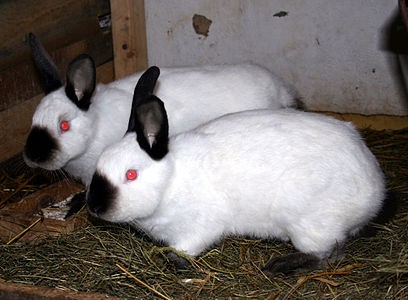
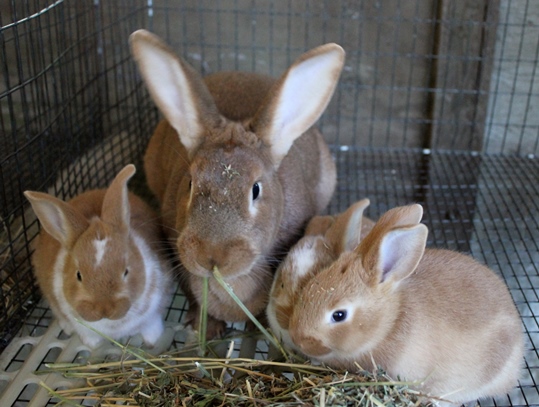
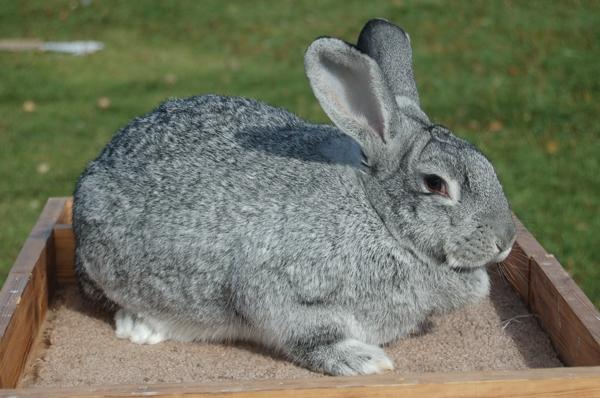
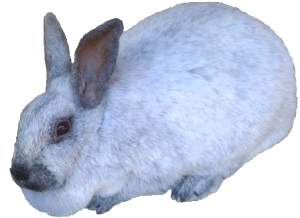
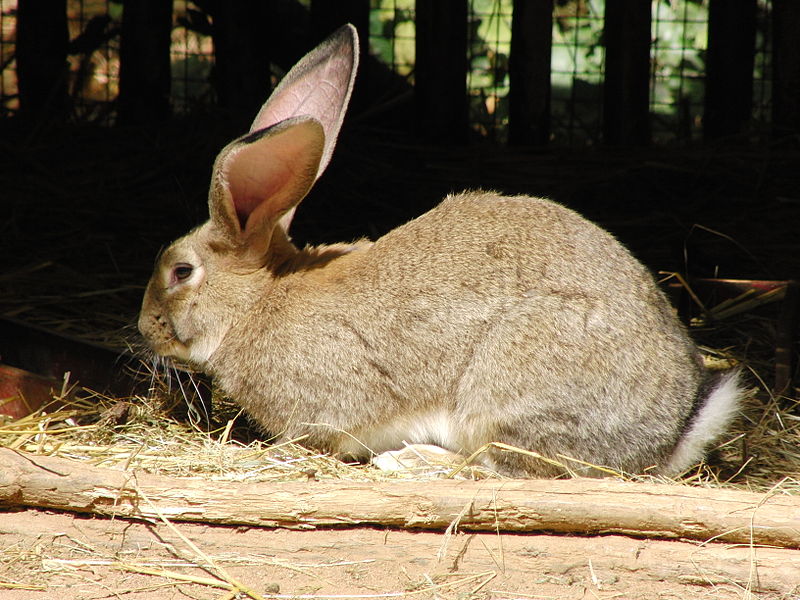
Other breeds are:
- Angora
- Mini Lop rabbit
- English Lop
- Holland Lop
- Dwarf Dutch
- Lion head
- Beaver Rex
- Chinchilla Rex
- Rex Albino
Rabbit Feeds and Feeding
The rabbit’s diet must be made up of three main elements: Hay, Fresh Feed, and Concentrate Feed. Of these, hay plays a fundamental role due to its contribution of fibre and must make up most of the diet of a healthy rabbit. Other elements, such as some seeds (nuts, cereals, legumes) should only be given in minimal quantities.
In general, we could divide the rabbit’s feeding as follows:
- 80% hay or fresh grass
- 15% fresh food (leafy vegetables or wild herbs)
- 5% concentrate feed
The feeds that you can give rabbits are:
Leafy vegetables: potato leaves, carrots, lettuces, cabbages. But only give lettuces and cabbages to adult rabbits alone.
- Hays: Well-cured green legumes hays such as cowpeas, groundnuts, soybeans, stylo, etc. are palatable and they make rabbits grow well.
- Starches and grains: potatoes (must be boiled) and grains such as millet, guinea corn, maize, rice, etc. can be added to the animal’s ration mixtures.
- Supplements: groundnut cake (GNC), cottonseed cake, and soybean meal (SBM) are protein-rich supplements, and they are desirable for balancing grass hays and pelleted rations. The grains and cakes are better accepted when crushed, ground, or missed thoroughly.
Feeding of Baby Rabbits
During the first 3 weeks, the only feed for the baby rabbits is the doe’s milk. After 2-3 weeks, the baby rabbits will start to eat the grass and concentrate, as well as suckle the doe. As they get older, they will adjust themselves to live entirely on the feeds from outside. Till the baby rabbits remain to suckle, their mother (doe) must get enough good quality feed (concentrates, green roughages and clean water) to sustain lactation demand. A lactating doe while nursing 8 young, will consume concentrates more than 250 g/day, while the water consumption may be as high as 3-5 liters/day. All vegetable rations are generally supplemented with salt and a source of calcium, such as a bone meal. Rations must include a balanced concentrates mixture.
Feeding of Adult Rabbits
Adult rabbits require all six nutrients, viz. water, carbohydrates, fat, protein, and all essential minerals and vitamins like human beings. By nature, rabbits fulfill their nutrient requirements through:
- Green bulky roughages, viz. grass, types of green vegetables, leaves and hay.
- Concentrates, feed low in crude fiber (under 20%) and high in energy. A concentrate mix is prepared by mixing more than one ingredient for enhancing the nutritional adequacy of the feed.
- Coprophagy is another important source of nutrients for rabbits which includes partially digested feed, containing protein, energy and vitamins that are needed by the rabbit.
- Water consumption takes place through the moisture content of feeds consumed and directly from drinking clean water.
A constant supply of fresh, clean water is essential for rabbits. Rabbits dislike dusty and gritty feeds and selectively eat certain ingredients of mashed feed. They prefer pelleted feed, which is also the scientific method of feeding rabbits in modern commercial rabbit farming. The advantages of pelleting are that it reduces the rabbits’ selection of preferred ingredients of the feed and improves growth performance by enhancing nutrient utilization. Pellets also require less storage space and are easier to transport.
Rabbits prefer pellets of 4 mm diameter and 10 mm length. Two types of pellets are used for:
- All-grain pellets, fed with hay or roughage
- Composite pellets contain all the elements of a balanced diet and roughage.
Read: Rabbit Feed Formulas
How to Pelletize Rabbit Feed
This is a technique for pelleting rabbit feed at home or on the farm. After selecting the raw material, thoroughly mix them by hand after sprinkling them with molasses and 40 percent water. Place the mash in a cotton bag and cook in a pressure cooker for 15 minutes. Feed the hot mixture into a meat mincer and extrude through a 6 mm plate to form pellets. Dry the pellets in the sun or in an oven at 80°C for four hours. Break up the pellets by hand and pack them.
Housing of Rabbits
Rabbits need to be housed to protect them and prevent them from running away. There are several ways of housing rabbits depending largely on the type of rabbit farming, i.e., whether backyard or big commercial type, climate, and the availability of finance. Backyard rabbit keepers who usually cannot afford to spend much on materials for their rabbitry, get satisfied with locally available old boxes, offcuts, bamboo, tin cans, etc. The small commercial farmers, on the other hand, may be interested in using moderately costly wire cages.
The most important features of housing are; rabbits must not only be protected from extremes of heat, sun and cold, wind, rain and predators but also should feel comfortable which includes proper space, suitable temperature, dry condition of the cages, proper ventilation along with some equipment like feeders, hoppers and hay rack.
On commercial farms, rabbits are kept mostly in wire mesh cages. These can be arranged in a single tier, but to make better use of the space in a building, they may be stacked in two or even three tiers. The cages in the upper tiers are set back so that no cage is directly above another, to allow the urine and feces to fall into the pit below. The selected arrangement must permit the staff to handle and feed all the rabbits easily. The cages are made of galvanized wire mesh, and the joints must be smooth. An even floor surface is essential to avoid causing abrasions on the under surfaces of the hind feet. A square mesh not exceeding 19 x 19 mm is favored as this allows fecal pellets to pass through and does not cause foot injuries.
The floor area must allow all the rabbits in the cage to lie comfortably and move around without disturbing the others and eat and drink without difficulty. For rabbits over 12 weeks of age, the height should not be less than 45 cm. A cage of this height, with a floor space of 0.56 m2, can accommodate one breeding buck or doe, a doe and litter up to 4 weeks of age, or eight weaners until marketed at 10 weeks old. Many farmers now use cages of this standard size.
READ: How to Build a Rabbit Cage or Hutch
Each cage should have a pellet hopper hooked to the front, and if the farmer feeds hay, a hay rack is also fitted outside the cage. For regular drinking water, an automatic watering system with a nipple drinker should be installed in each cage. To minimize cost, one litter bottles fixed to the side of the cage can be arranged to provide drinking water using the following two methods as described below:
- The mouth of the bottle is arranged over a shallow tray, most of which is inside the cage. Water passes from the bottle into the tray until stopped by atmospheric pressure. The rabbits drink from the tray and water flows in to replace what they have drunk.
- A 6 mm glass tube leads from the bottle into the cage. The end of the tube should be rounded in a flame so that it is not sharp. Rabbits will soon learn to suck water through the tube. Owing to the narrow diameter of the tube, water will not pass through it without the small amount of suction that the rabbits can exert.
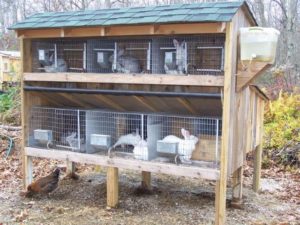
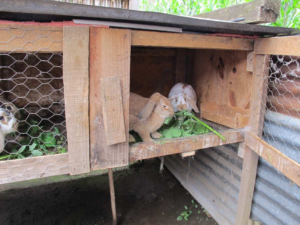
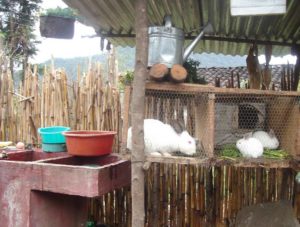
Proper Sanitary Management
What are the conditions for proper sanitary management in rabbits?
- Rabbit ventilation is essential if you want to have healthy animals.
- Inspect rabbits well every day so that no disease goes unnoticed.
- Examine the eyes, noses, ears, and anus, in order to discover any symptoms of scabies, pus in the ear, diarrhea, ringworm, etc.
- Take care of diseases quickly.
- Immediately that a sick rabbit is noticed, it must be separated from the others and the cage must be disinfected.
- Periodically wash cages, feeders and troughs with plenty of water and disinfectant, removing feces, hairs, etc.
- Periodically remove the manure.
- Fight rats and mice.
- Incinerate and bury dead animals.
- It is good to build a quarantine cage. This is a remote cage to house sick, suspicious, or new animals.
Common Diseases of Rabbits
- Internal parasites such as worm infestation, coccidial infection, etc. Deworm animals regularly and avoid giving animals moldy feeds. Also, administer coccidiostat at an early age or anti-coccidial drugs.
- External parasites such as mites and lice infestation. Clean the hutches regularly.
- Bacterial infections such as Salmonellosis, Escherichia coli (E. coli), etc.
- Viral infections such as Myxomatosis (Big head disease), and Rabbit Calicivirus disease (Viral hemorrhagic disease).
How to Handle Rabbits Correctly
Handling rabbits correctly is very important because rough handling can be a source of stress to rabbits (they are not as rugged as other animals like pigs, cattle, or goats). The skeleton of rabbits is not strong. Their backbone can be easily damaged. Hence, care should be taken seriously when handling this set of animals.
One thing is that a rabbit should on any condition lifted by their ears because it is usually painful to them. There are two ways rabbits can be handled. These are:
- By the scruff: The rabbit handler must have short fingernails to prevent injuring the animal. The rabbit should be lifted by the skin behind the ears (the scruff). The rabbit is then held and supported by placing the order hand under its hindquarters. Never hold the back legs as this action may cause the animal to struggle and kick or injure you with its sharp claws.
- By the pelvis: This method is used to handle young rabbits (kits) only. The young rabbits being transferred quickly from the hutch to the basket may be lifted by the pelvis or the skin on their back.
Since rabbit farming is cheap and easy to manage, why don’t you take a bold step and start one even if you are starting with a few rabbits?
Download the Free Rabbit Farming eBook
If you want more comprehensive information on how to raise rabbits including how to build a rabbit cage or hutch, then you should download the eBook below. It contains everything you need to get started.
Click Here to Download a comprehensive eBook on Backyard Rabbit Keeping
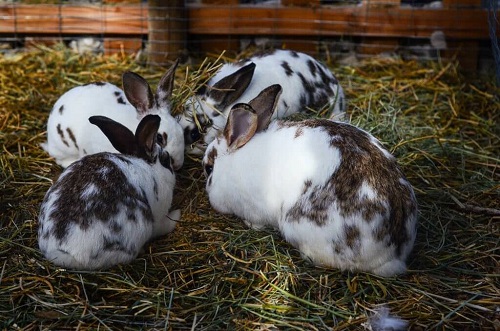
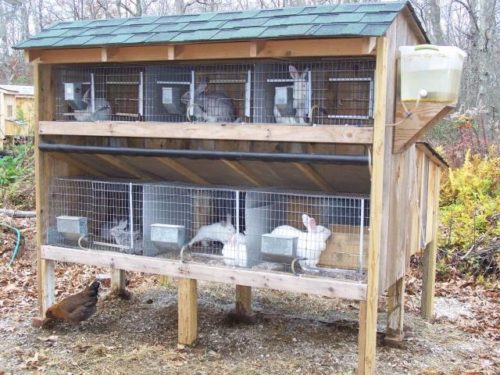
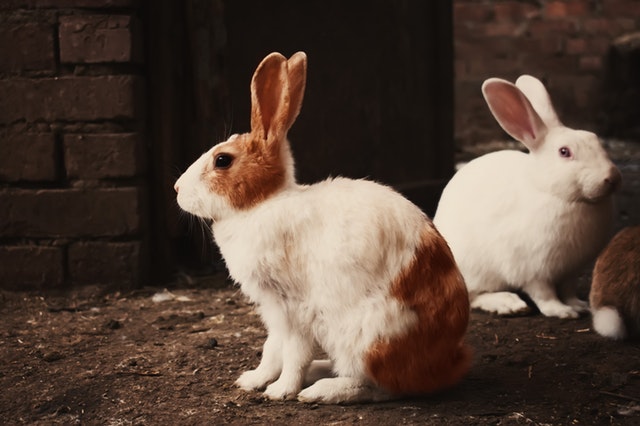
Hello Sir,
Glad I found your site. I’m seeking a farm planner for grass cutter, rabbits, ostrich and snails. Is this a service you render? Please let’s discuss further. Thanks.
Yes, of course. I will send you a mail.
Is it possible to make money on a smaller scale to supplement my become not to rely on this being my only source of income?
CAN I START A RABBIT FARM INDOORS OR CAN I USE MY BALCONY
You can use the balcony if there is not space at your backyard.
HOW MUCH WILL IT COST TO START A RABBIT FARM
SMALL SCALE PLEASE
You can even start with as low as 50k. It all depend on the number of rabbits and the materials used to construct the cage.
IF SAY I WANT TO START WITH 100K IS IT VISIBLE AND HOW MUCH WILL I MAKE
PLEASE HOW MUCH WILL I BUY
HOW MUCH WILL I SELL
It is feasible but you must survey and analyse your market to confirm.
Can a chicken cage be modified to hold rabbits and what are the requirements for one to start small scale rabbit farming. I wanted to start with around five rabbits.
Yes, you can modify a chicken cage. However, it depends on the carpenter who will do the work. Download the ebook attached to this post. It will help you greatly. Happy Farming!
Hello can you recommend someone to construct for me rabbit cages and at how much?
Constructing rabbit cages shouldn’t be a difficult thing for a trained carpenter. Just give him a design and you’re good to go.
Good day, I am glad to have come across this information, given the fact that I want to start my own one day.
Could you please send me any if not all ebooks you might have on rabbit farming, and other things I might need to Know about this kind of farming
Kind Regards
I will check my ebook archive and send them to you.
i will be glad to share experience on this forum
You’re welcome Rajab. If you want to share anything with the community, kindly send an email to info[at]livestocking.net
Please I need a copy of a rabbit business plan my email address is [email protected] thanx
Sir i will like to start a rabbit business and i want to know how much a fully grown male and female rabbit costs. Can i get an e book to get more understanding. Thanks
Sir I want to start a rabbit farm in Pakistan.but here is no rabbit meat or skin market. This is abig problem 4 me.please guided me on this issue
Then don’t start the farm yet, except you would like to process, package and export the rabbit products.
How American chinchilla am Michael i
woul want you to post to me the rabit farming ebook please
which countries are the biggest consumers of rabbit meat?
who are my target market for rabbit farming , i have issues with who to sell to
Meat processors, supermarkets and pet lovers.